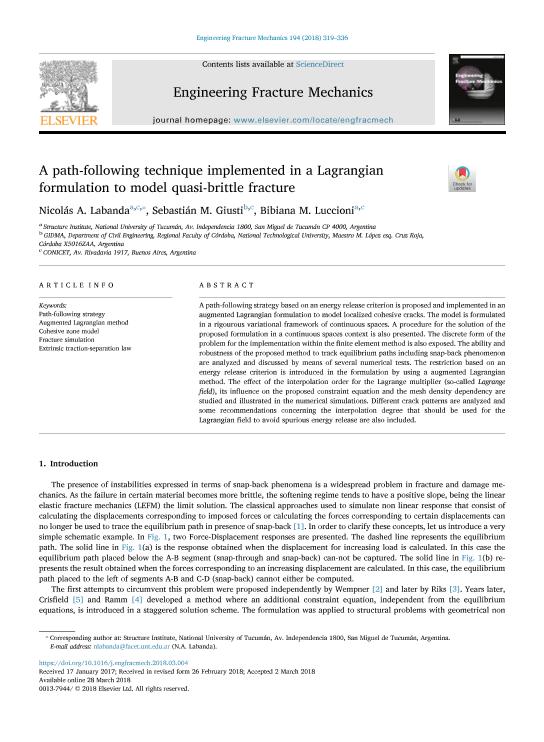Artículo
A Path-following technique implemented in a Lagrangian formulation to model quasi-brittle fracture
Fecha de publicación:
03/2018
Editorial:
Pergamon-Elsevier Science Ltd
Revista:
Engineering Fracture Mechanics
ISSN:
0013-7944
Idioma:
Inglés
Tipo de recurso:
Artículo publicado
Clasificación temática:
Resumen
A path-following strategy based on an energy release criterion is proposed and implemented in an augmented Lagrangian formulation to model localized cohesive cracks. The model is formulated in a rigourous variational framework of continuous spaces. A procedure for the solution of the proposed formulation in a continuous spaces context is also presented. The discrete form of the problem for the implementation within the finite element method is also exposed. The ability and robustness of the proposed method to track equilibrium paths including snap-back phenomenon are analyzed and discussed by means of several numerical tests. The restriction based on an energy release criterion is introduced in the formulation by using a augmented Lagrangian method. The effect of the interpolation order for the Lagrange multiplier (so-called Lagrange field), its influence on the proposed constraint equation and the mesh density dependency are studied and illustrated in the numerical simulations. Different crack patterns are analyzed and some recommendations concerning the interpolation degree that should be used for the Lagrangian field to avoid spurious energy release are also included.
Archivos asociados
Licencia
Identificadores
Colecciones
Articulos(CCT - CORDOBA)
Articulos de CTRO.CIENTIFICO TECNOL.CONICET - CORDOBA
Articulos de CTRO.CIENTIFICO TECNOL.CONICET - CORDOBA
Articulos(CCT - NOA SUR)
Articulos de CTRO.CIENTIFICO TECNOL.CONICET - NOA SUR
Articulos de CTRO.CIENTIFICO TECNOL.CONICET - NOA SUR
Citación
Labanda, Nicolás Agustín; Giusti, Sebastian Miguel; Luccioni, Bibiana Maria; A Path-following technique implemented in a Lagrangian formulation to model quasi-brittle fracture; Pergamon-Elsevier Science Ltd; Engineering Fracture Mechanics; 194; 5; 3-2018; 319-336
Compartir




